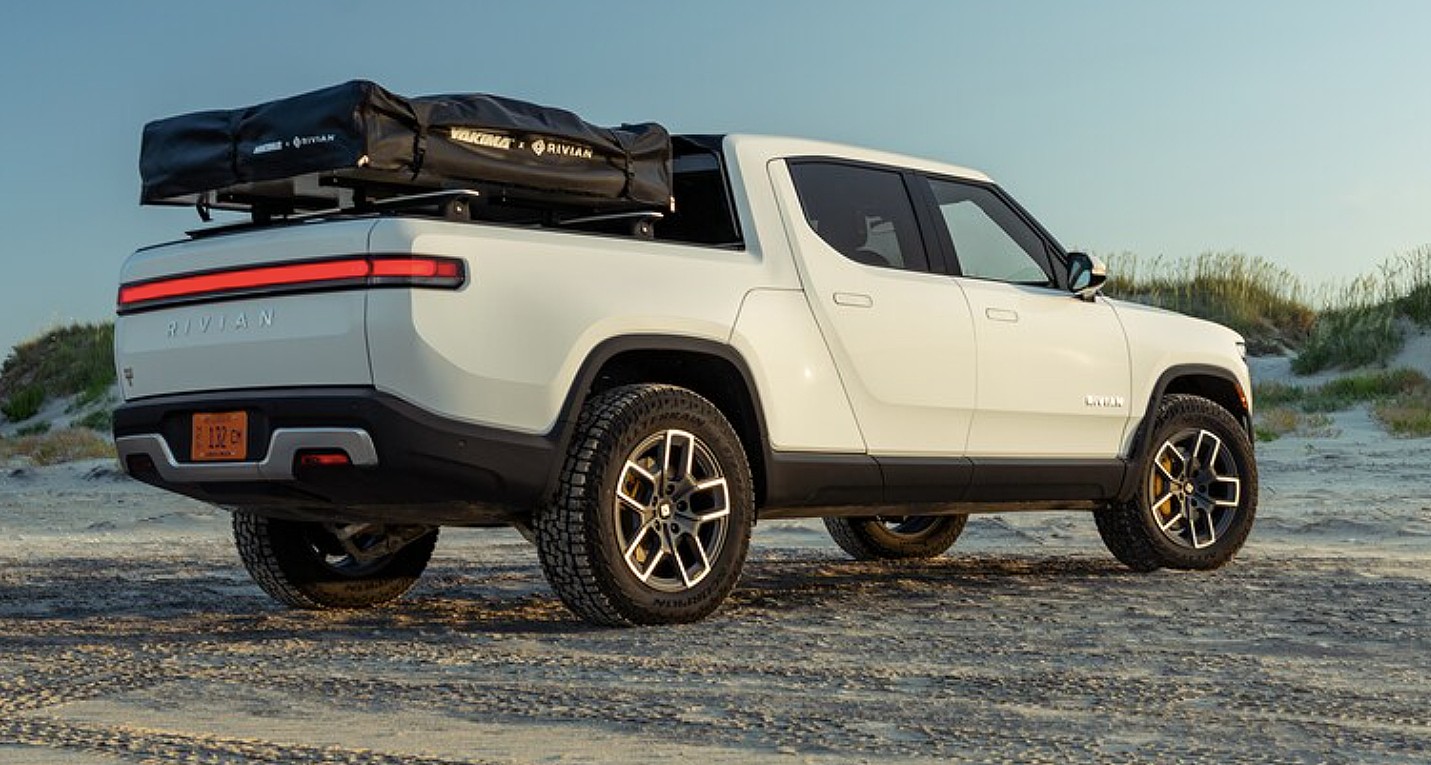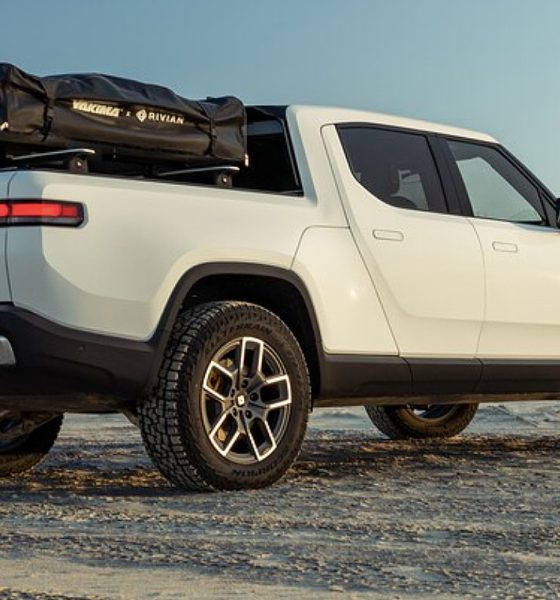

News
Rivian R1T gets glowing review after first drive: “the most remarkable pickup”
The Rivian R1T recently received a glowing review, thanks to its apparent seamless combination of bleeding-edge technology and classic pickup truck capabilities. The review, which was published by automotive news outlet MotorTrend, may very well be the first of many positive responses that the R1T would receive when it begins customer deliveries later this month.
The Rivian R1T was unveiled in late 2018 with an estimated 2020 production date. Similar to other automakers, however, Rivian was hit by the pandemic last year and this year’s ongoing chip shortage and supply chain issues. These challenges ended up delaying Rivian’s R1T deliveries to this month, September 2021. But if the vehicle’s first drive review is any indication, it appears that the wait is definitely worth it for the all-electric pickup truck.
The publication entered that the Rivian R1T’s killer features are its powertrain and suspension setup. With four electric motors and height-adjustable air suspension, the R1T is both quick on the pavement and capable off-road. By having one motor for each of its wheels, the R1T offers real-time torque vectoring as well, allowing the vehicle to deliver power exactly where it’s needed.
Rivian’s drive modes represent the best that the company’s torque vectoring capabilities could offer. The R1T features several drive modes, such as “All-Purpose,” which is both swift and sure-footed, “Conserve,” which maximizes efficiency by turning the vehicle into a front-wheel drive pickup truck, and “Sport,” which strangely makes the R1T handle and behave like a sports car. Just like other premium electric vehicles, the R1T is very quick and very smooth on the road.
But inasmuch as the Rivian R1T is capable on paved roads, the all-electric pickup truck truly shines when the vehicle goes off-road. MotorTrend noted that the R1T could rival a Jeep Wrangler at times, as it is capable of traversing obstacles that may give its internal combustion-powered peers a difficult time. The fact that the R1T’s ground clearance ranges from 7.9 inches to a whopping 14.4 inches is impressive, and it allows the vehicle to take on even the most unforgiving terrains.
The glowing review of the R1T continues to its storage spaces, which are very generous in the vehicle. However, the publication did highlight that the R1T is not perfect, as its infotainment system’s user interface needs improvement. The R1T’s rear seats are also best for passengers who are not very tall, as their upright backseat and firm seats seem designed more for utility than comfort. Legroom, however, is generous.
The Rivian R1T is an adventure truck that is made for people who love the outdoors, and ultimately, this is perhaps the vehicle’s greatest asset. Rivian is pretty much staffed by people who live and breathe adventure, after all, particularly its CEO, RJ Scaringe. Based on what MotorTrend has stated about the vehicle so far, it appears that the R1T, in more ways than one, is the perfect adventure pickup created for the outdoors by people who also love the outdoors. And that in itself is a pretty darn good balance to have.
Watch MotorTrend‘s first drive of the Rivian R1T in the video below.
Don’t hesitate to contact us with account tips. Just send a message to tips@teslarati.com to give us a heads up.

Elon Musk
SpaceX issues statement on Starship V3 Booster 18 anomaly
The incident unfolded during gas-system pressure testing at the company’s Massey facility in Starbase, Texas.

SpaceX has issued an initial statement about Starship Booster 18’s anomaly early Friday. The incident unfolded during gas-system pressure testing at the company’s Massey facility in Starbase, Texas.
SpaceX’s initial comment
As per SpaceX in a post on its official account on social media platform X, Booster 18 was undergoing gas system pressure tests when the anomaly happened. Despite the nature of the incident, the company emphasized that no propellant was loaded, no engines were installed, and personnel were kept at a safe distance from the booster, resulting in zero injuries.
“Booster 18 suffered an anomaly during gas system pressure testing that we were conducting in advance of structural proof testing. No propellant was on the vehicle, and engines were not yet installed. The teams need time to investigate before we are confident of the cause. No one was injured as we maintain a safe distance for personnel during this type of testing. The site remains clear and we are working plans to safely reenter the site,” SpaceX wrote in its post on X.
Incident and aftermath
Livestream footage from LabPadre showed Booster 18’s lower half crumpling around the liquid oxygen tank area at approximately 4:04 a.m. CT. Subsequent images posted by on-site observers revealed extensive deformation across the booster’s lower structure. Needless to say, spaceflight observers have noted that Booster 18 would likely be a complete loss due to its anomaly.
Booster 18 had rolled out only a day earlier and was one of the first vehicles in the Starship V3 program. The V3 series incorporates structural reinforcements and reliability upgrades intended to prepare Starship for rapid-reuse testing and eventual tower-catch operations. Elon Musk has been optimistic about Starship V3, previously noting on X that the spacecraft might be able to complete initial missions to Mars.
Investor's Corner
Tesla analyst maintains $500 PT, says FSD drives better than humans now
The team also met with Tesla leaders for more than an hour to discuss autonomy, chip development, and upcoming deployment plans.

Tesla (NASDAQ:TSLA) received fresh support from Piper Sandler this week after analysts toured the Fremont Factory and tested the company’s latest Full Self-Driving software. The firm reaffirmed its $500 price target, stating that FSD V14 delivered a notably smooth robotaxi demonstration and may already perform at levels comparable to, if not better than, average human drivers.
The team also met with Tesla leaders for more than an hour to discuss autonomy, chip development, and upcoming deployment plans.
Analysts highlight autonomy progress
During more than 75 minutes of focused discussions, analysts reportedly focused on FSD v14’s updates. Piper Sandler’s team pointed to meaningful strides in perception, object handling, and overall ride smoothness during the robotaxi demo.
The visit also included discussions on updates to Tesla’s in-house chip initiatives, its Optimus program, and the growth of the company’s battery storage business. Analysts noted that Tesla continues refining cost structures and capital expenditure expectations, which are key elements in future margin recovery, as noted in a Yahoo Finance report.
Analyst Alexander Potter noted that “we think FSD is a truly impressive product that is (probably) already better at driving than the average American.” This conclusion was strengthened by what he described as a “flawless robotaxi ride to the hotel.”
Street targets diverge on TSLA
While Piper Sandler stands by its $500 target, it is not the highest estimate on the Street. Wedbush, for one, has a $600 per share price target for TSLA stock.
Other institutions have also weighed in on TSLA stock as of late. HSBC reiterated a Reduce rating with a $131 target, citing a gap between earnings fundamentals and the company’s market value. By contrast, TD Cowen maintained a Buy rating and a $509 target, pointing to strong autonomous driving demonstrations in Austin and the pace of software-driven improvements.
Stifel analysts also lifted their price target for Tesla to $508 per share over the company’s ongoing robotaxi and FSD programs.
Elon Musk
SpaceX Starship Version 3 booster crumples in early testing
Photos of the incident’s aftermath suggest that Booster 18 will likely be retired.

SpaceX’s new Starship first-stage booster, Booster 18, suffered major damage early Friday during its first round of testing in Starbase, Texas, just one day after rolling out of the factory.
Based on videos of the incident, the lower section of the rocket booster appeared to crumple during a pressurization test. Photos of the incident’s aftermath suggest that Booster 18 will likely be retired.
Booster test failure
SpaceX began structural and propellant-system verification tests on Booster 18 Thursday night at the Massey’s Test Site, only a few miles from Starbase’s production facilities, as noted in an Ars Technica report. At 4:04 a.m. CT on Friday, a livestream from LabPadre Space captured the booster’s lower half experiencing a sudden destructive event around its liquid oxygen tank section. Post-incident images, shared on X by @StarshipGazer, showed notable deformation in the booster’s lower structure.
Neither SpaceX nor Elon Musk had commented as of Friday morning, but the vehicle’s condition suggests it is likely a complete loss. This is quite unfortunate, as Booster 18 is already part of the Starship V3 program, which includes design fixes and upgrades intended to improve reliability. While SpaceX maintains a rather rapid Starship production line in Starbase, Booster 18 was generally expected to validate the improvements implemented in the V3 program.
Tight deadlines
SpaceX needs Starship boosters and upper stages to begin demonstrating rapid reuse, tower catches, and early operational Starlink missions over the next two years. More critically, NASA’s Artemis program depends on an on-orbit refueling test in the second half of 2026, a requirement for the vehicle’s expected crewed lunar landing around 2028.
While SpaceX is known for diagnosing failures quickly and returning to testing at unmatched speed, losing the newest-generation booster at the very start of its campaign highlights the immense challenge involved in scaling Starship into a reliable, high-cadence launch system. SpaceX, however, is known for getting things done quickly, so it would not be a surprise if the company manages to figure out what happened to Booster 18 in the near future.








